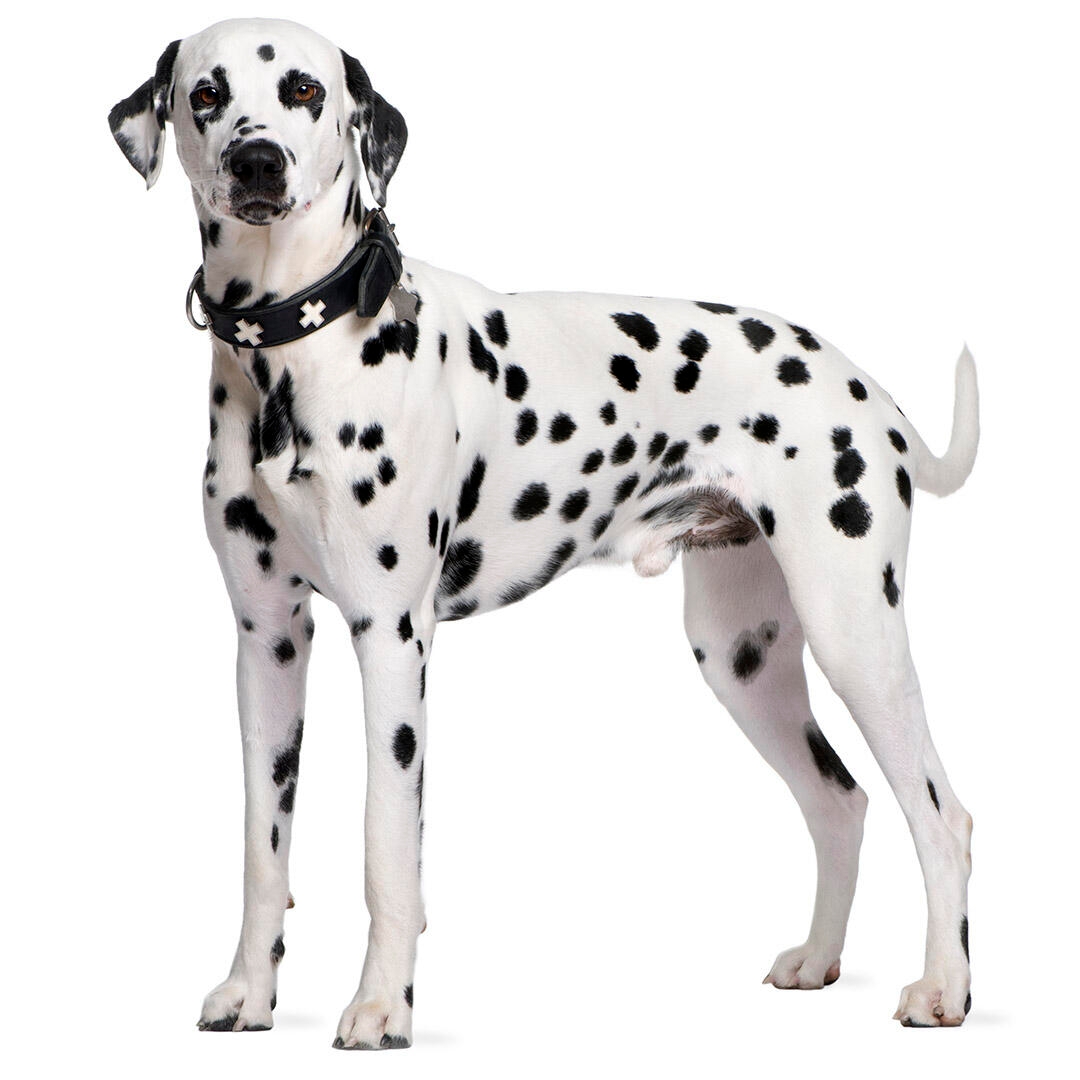
| Family-friendly: | 5/5 |
| Exercise needs: | 5/5 |
| Easy to train: | 4/5 |
| Tolerates being alone: | 3/5 |
| Likes other pets: | 4/5 |
| Energy level: | 5/5 |
| Grooming needs: | 4/5 |
| Shedding: | 5/5 |
Deafness is the most common health problem within the Dalmatian breed.
Dalmatians can also be prone to:
- Hip dysplasia
- Urate stones which are a particular type of bladder stone made up of uric acid. Dalmatians are often not able to process this substance which result in a build up of uric acid deposits in the bladder and sometimes the kidneys.
- Epilepsy¹ which is a condition where abnormal brain function can lead to seizures which damage the brain.
- Atopy where the skin reacts to allergens in the environment and becomes sore and itchy.
Priority Kennel Club health schemes and testing:
- Hearing testing (BAER programme)
¹ C. Rusbridge, 'Canine idiopathic epilepsy', May 2016, Veterinary Ireland Journal.
The Dalmatian is friendly and outgoing, but if they are insufficiently exercised they can become hyperactive and difficult to live with. Dalmatians are dedicated and loyal and always want to please; they enjoy company and clowning about so can make great dogs for an active family, however, their strength and stamina - and need for almost endless exercise and stimulation - can sometimes be too much of a challenge for unprepared owners.
| Family-friendly: | 5/5 |
| Exercise needs: | 5/5 |
| Easy to train: | 4/5 |
| Tolerates being alone: | 3/5 |
| Likes other pets: | 4/5 |
| Energy level: | 5/5 |
| Grooming needs: | 4/5 |
| Shedding: | 5/5 |
Despite their name, it would seem that the Dalmatian is primarily an English breed with their first recorded use being by Thomas Berwick in 1791. Also known as the Spotted Coach Dog, not only are they the only truly spotted breed in the world, but they are also the only dedicated carriage dogs, bred to run alongside coaches either as a guard or a status symbol.
Dalmatians would accompany farmers’ wives and their pack ponies to market to ensure her safety. They were so good at this job that they began running alongside carriages to deter highwaymen - but as they were so showy they quickly became status symbols for the wealthy. They also found work running alongside horse-drawn fire engines. Their history may account for their reported affinity with horses.
Dallies draw attention wherever they go so people will know you as ‘the person with the spotty dogs’ even if they don’t know your name! Dallie owners must also be prepared to be covered in shed hair, and ownership of a robot vacuum cleaner is highly recommended. Otherwise, you should be capable of extremely long and active daily walks and plenty of training, and living somewhere with good access to a variety of country walks. Dallies will suit homes with older children or a child-free home as long as someone is home most of the time.
This is a dog who was bred to run - all day, every day - and for most Dalmatians, this is their greatest joy. Couch potatoes need not apply! Dalmatians will need upwards of two hours of dog exercise every single day come rain or shine - and this needs to include free running. An under-exercised Dalmatian is difficult to live with. For an active owner however, the Dalmatian is a total joy as they will be up for every outing and will accompany even the most extreme fitness fanatics wherever they want to go. As with all dogs however, take care not to over-exercise puppies.
The Dalmatian is a large dog with extreme exercise requirements - and so needs a rural location and plenty of space.
Your dog's diet needs to have the right balance of all the main nutrient groups including a constant supply of fresh water. It's also important to conduct regular body condition scores to ensure you keep your dog in ideal shape and remember to feed him at least twice daily and in accordance with the feeding guidelines of their particular food.
Because of their short and hard hairs, the Dalmatian breed does not require much in the way of dog grooming. Once a week run a grooming mitt over their coats to remove dead hairs, finishing off with a soft cloth to promote shine. They do shed however and you will find that their hairs seem to be stubborn to remove from furnishings and so covers may help.
Dalmatians need plenty of early and ongoing dog socialisation, and also training to walk on a lead and harness. Also, as they need lots of free-running, owners must work to ensure they have a reliable recall. Most Dalmatians are easy to train as they enjoy working with their owners - although their exuberance sometimes means they can have a short attention-span!
As long as they get the exercise they need, the Dalmatian can make an excellent addition to an active energetic family - but they may be too boisterous for younger children (and few parents of younger children have the time to devote to their exercise needs).
While many dogs are traditionally thought of as being good with children, all dogs and children need to be taught to get on with each other and be safe together. Even so, dogs and young children should never be left alone together and adults should supervise all interactions between them.